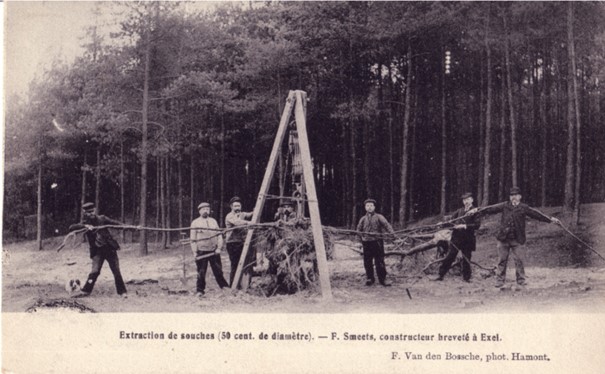The Eye of the (Pine) Needle. Landscape Perceptions and Local Engagement with Pine Forests in the Campine
Noor Van Roy
Master Erfgoedstudies
2024 — 2025
onderzoek
promotoren
Tim De Kock
Niels Dabaut
A postcard with the extraction of tree roots with a pine tree plantation in the background. (F. Van den Bossche, “Extraction de souches (50 cent. de diamètre. – F. Smeets, constructeur breveté à Exel”, 1903, Hamont, Postcard collection Belfius Bank, Obj. No. B00014638, Deposited at the Académie Royale de Belgique)
The Eye of the (Pine) Needle. Landscape Perceptions and Local Engagement with Pine Forests in the Campine
This thesis explores how local communities in Belgium’s Campine region perceive and engage with pine forests. Although often deemed ecologically problematic, these landscapes are deeply embedded in local memory, identity, and everyday experiences. Through case studies in Averbode Bos & Heide and the Beeltjens, the research advocates for more inclusive landscape management that recognises emotional and cultural attachments alongside ecological priorities and the prevailing preference for restoring heathland landscapes.
This thesis investigates how local communities in Belgium’s Campine region perceive and engage with pine forests, landscapes that are increasingly subject to ecological and policy-driven transformations. Structured in two parts, the thesis develops a conceptual framework grounded in landscape studies, heritage theory, and environmental history. The second part applies this framework in an empirical study based on qualitative fieldwork in two case study areas: Averbode Bos & Heide and the Beeltjens.
Originally planted in the 19th and 20th centuries for industrial purposes, pine forests are now often targeted for ecological restoration due to their connection with biodiversity loss and limited climate change resilience. As a result, Campine’s pre-industrial landscapes such as heathlands are frequently prioritised in restoration efforts and heritage valuation. However, this thesis demonstrates that pine forests continue to hold meaning and value, not in opposition to heathlands, but alongside them.
Through interviews and a focus group, the research uncovers how emotional attachments, nostalgia, and a sense of place shape people’s responses to landscape change. It argues that management frameworks often overlook these lived experiences, favouring top-down approaches that risk alienating local communities. These exclusions stem from entrenched professional paradigms that prioritise measurable ecological outcomes and pre-industrial histories over cultural and emotional values.
By foregrounding local voices, the thesis calls for a more participatory and context-sensitive approach to landscape management. In doing so, it contributes to broader debates on how landscapes can be managed in both ecologically and socially sustainable ways.



